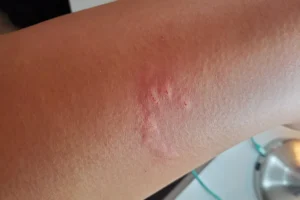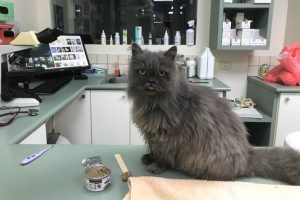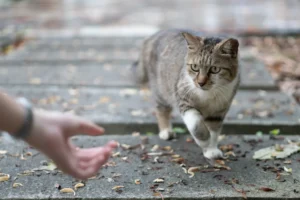Cat scratches can often lead to profuse bleeding, leaving many wondering why a seemingly minor scratch from a cute feline friend can result in such a dramatic display of blood. The reason behind why cat scratches bleed so much is a fascinating one, delving into the unique anatomy of cats and their claws.
Cat scratches bleed so much due to the structure of a cat’s claws and the bacteria they may carry.
The Anatomy of a Cat’s Claw
Have you ever wondered why cat scratches seem to bleed so much more than scratches from other animals? It all comes down to the sharpness and design of a cat’s claws. Unlike some other animals whose claws are more blunt, a cat’s claws are sharp and curved, designed for hunting and climbing. This sharpness means that when a cat scratches, the claws can easily pierce the skin, causing more significant wounds that are more likely to bleed.
It’s also important to note that a cat’s claws are retractable, meaning they can extend and retract them as needed. This ability to extend their claws allows them to use them as a weapon or for climbing, while retracting them helps keep their claws sharp. When a cat scratches, the quick and forceful extension of their claws can result in deeper and more severe cuts, leading to increased bleeding compared to other animals.
Why Do Cats Scratch?
When it comes to cat behavior, scratching is a natural instinct that serves several purposes. Cats scratch to stretch their muscles and remove the outer sheath of their claws, keeping them sharp. Scratching also helps cats mark their territory, as they have scent glands in their paw pads that leave behind their scent when they scratch.
Additionally, scratching is a way for cats to release pent-up energy and express emotions like frustration or excitement. When a cat scratches, they are engaging in a normal and instinctual behavior that is essential for their physical and emotional well-being.
One unique insight to consider is that the environment can play a significant role in why cats scratch and why their scratches may bleed more. Providing appropriate scratching posts and regular nail trims can help reduce the likelihood of excessive bleeding from cat scratches. By understanding the natural behaviors of cats and providing them with the right outlets for scratching, you can help minimize the risk of bleeding from their scratches.
The Importance of Cleaning Cat Scratches
Cat scratches are prone to bleeding more than other types of wounds due to the structure of a cat’s claws. Cats have retractable claws that they use for hunting and climbing, and these claws are designed to be sharp and efficient. When a cat scratches, their sharp claws can easily penetrate the skin, causing deeper and more extensive wounds compared to a blunt object.
To prevent infections from the bacteria present on a cat’s claws, it is crucial to promptly clean and treat cat scratches. Cleaning the wound with soap and water can help remove any dirt or debris that may have been introduced by the scratch. Applying an antiseptic solution and covering the scratch with a bandage can also help prevent infection and promote faster healing.
If you notice any signs of infection such as increased redness, swelling, or pus around the scratch, it is essential to seek medical attention promptly. In some cases, cat scratches can lead to serious infections like cat scratch fever, which is caused by bacteria transmitted through a cat scratch or bite. By cleaning cat scratches promptly and ensuring proper wound care, you can reduce the risk of complications and promote faster healing.
How to Stop a Cat Scratch from Bleeding
When dealing with a cat scratch that is bleeding, it is essential to remain calm and take immediate steps to stop the bleeding. Begin by applying gentle pressure to the wound with a clean cloth or gauze pad. This pressure can help slow down and eventually stop the bleeding.
Next, clean the wound with soap and water to prevent infection. You can also apply an over-the-counter antibiotic ointment to the scratch before covering it with a bandage. Avoid using hydrogen peroxide or alcohol, as these can be too harsh on the wound and slow down the healing process.
If the bleeding does not stop or if the scratch is particularly deep or long, seek medical attention for further evaluation and treatment. A healthcare professional can assess the wound and provide appropriate care to prevent infection and promote healing.
Tips to Stop Cat Scratch Bleeding:
– Apply gentle pressure to the wound using a clean cloth.
– Clean the scratch with soap and water.
– Use an over-the-counter antibiotic ointment.
– Cover the scratch with a bandage.
– Seek medical attention for deep or persistent bleeding.
Remember, proper wound care and prompt treatment are essential to prevent complications and promote healing when dealing with cat scratches. By following these tips, you can effectively stop the bleeding and ensure proper healing of the scratch.
Managing Cat Scratch Infections
Cat scratch wounds have the potential to become infected if not properly cared for. It’s crucial to keep an eye out for signs of infection, such as redness, swelling, warmth, or pus coming from the wound. If you notice any of these symptoms, it’s essential to seek medical attention promptly to prevent further complications. Remember, prevention is always better than cure when it comes to infections.
Closely monitoring the wound is key to preventing infection. Clean the scratch with mild soap and warm water, apply an antiseptic ointment, and cover it with a bandage. Keep an eye on the scratch for any changes in appearance or symptoms, and seek medical advice if you have any concerns about infection. It’s better to be safe than sorry when it comes to cat scratch wounds.
If the scratch appears to be worsening or not healing properly, don’t hesitate to seek professional medical help. A healthcare provider can assess the wound, prescribe antibiotics if necessary, and provide guidance on how to care for the scratch properly. Remember, early intervention is key to preventing complications from cat scratch infections.
For more information on managing cat scratch infections, you can refer to this helpful resource from the American Academy of Dermatology: How to Prevent and Treat Cat Scratch Disease
Do Cat Scratches Always Bleed?
Cat scratches vary in their severity, and not all cat scratches bleed profusely. The amount of bleeding can depend on factors such as the depth of the scratch, the location on the body, and individual differences in clotting ability. Superficial scratches may not bleed much, while deeper or jagged scratches are more likely to cause significant bleeding.
If you notice a cat scratch bleeding excessively, apply pressure to the wound with a clean cloth or bandage to help stop the bleeding. Elevating the affected limb can also help reduce bleeding. Remember, it’s essential to clean the wound thoroughly to prevent infection, even if it doesn’t bleed much initially.
To promote healing, keep the scratch clean and dry, and avoid scratching or picking at the scab. If the bleeding persists or the wound shows signs of infection, don’t hesitate to seek medical attention. It’s always better to be cautious and proactive when it comes to managing cat scratches.
Remember, not all cat scratches bleed the same, so it’s essential to assess each scratch individually and provide appropriate care based on its severity.
Fun Cat Scratch Facts
Want to impress your friends with some quirky cat knowledge? Here are some fun facts about cat scratches that you might not know:
1. Hunting Instincts: Cats scratch as a natural instinct to mark their territory and sharpen their claws. So, when your cat gives you a scratch, they might just be staking their claim!
2. Antibacterial Properties: Believe it or not, cat scratches can actually have antibacterial properties. Some researchers suggest that the saliva on a cat’s claws contain enzymes that help clean the wound. Pretty purr-fect, right?
3. Bleeding Factor: One reason why cat scratches seem to bleed so much is due to the structure of a cat’s claws. They are sharp and designed to grip prey, which means they can easily pierce the skin and cause more bleeding compared to a blunt object.
4. Healing Powers: Despite the initial shock of a bloody scratch, cat scratches actually tend to heal quite quickly. This is because a cat’s saliva contains enzymes that can aid in the healing process. So, while it may look bad, your scratch should be on the mend in no time.
5. Playful Behavior: Cats often scratch when they are feeling playful or energetic. So, if your furry friend gives you a scratch during playtime, it might just be their way of showing affection and having fun.
Next time your cat leaves you with a scratch, remember these fun facts to gain a new appreciation for your feline friend’s unique behaviors.
Alex, a passionate animal lover, has experience in training and understanding animal behavior. As a proud pet parent to two dogs and three cats, he founded AnimalReport.net to share insights from animal experts and expand his knowledge of the animal kingdom.









